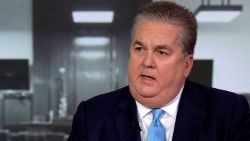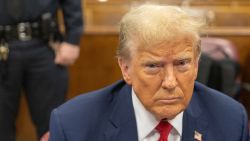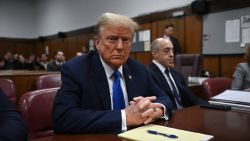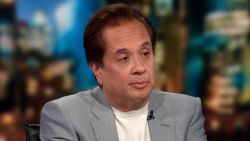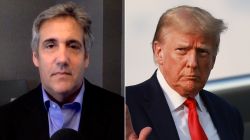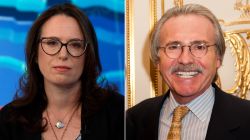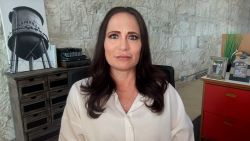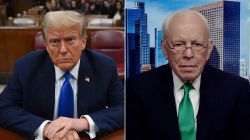President Donald Trump made a conventional kind of presidential appearance last week, delivering a speech about the economy to a gathering of New York City corporate elites.
He then made 29 false claims in 71 minutes.
It isn’t only rally speeches in which Trump is relentlessly dishonest. His address to the Economic Club of New York was littered with inaccurate economic statistics, baseless claims about environmental policy, and one of his signature fictional tales about people crying in gratitude at one of his events.
Trump made 53 false claims in all last week. That was below his average of 66 false claims per week for the 19 weeks we have tracked at CNN. Through Sunday, Trump had made 1,255 total false claims since we started counting on July 8.
The economy was the top subject of Trump’s dishonesty last week, with 15 false claims – the first time in seven weeks that neither his Ukraine scandal or Democrats’ related impeachment inquiry topped the list.
The impeachment inquiry came second last week, with 13 false claims.
The most egregious false claim: Schiff’s non-doctoring
Trump predicted on November 2 and again on November 3 that Democratic Rep. Adam Schiff would fraudulently alter any transcripts the House Intelligence Committee, which Schiff chairs, might release of closed-door impeachment inquiry testimony.
The committee then began releasing transcripts. None of the Republican members of the committee, and none of the witness who testified, alleged that any of these transcripts had been doctored in any way.
Trump was, naturally, undeterred. He tweeted November 11 that “Schiff will only release doctored transcripts.”
Before the transcripts were released, this was merely a highly dubious prediction. After the transcripts were released, it was an inaccurate smear.
The most revealing false claim: An assumption on health care
Trump held a Friday event at the White House to herald two new rules to increase transparency in health care pricing.
“First,” he said, “we are finalizing a rule that will compel hospitals to publish prices publicly online for everyone to see and to compare. So you’re able to go online and compare all of the hospitals and the doctors and the prices, and, I assume, get resumes on doctors and see who you like.”
The first part, his scripted line about hospitals publishing price information, was correct. The last part, his apparent ad-lib about people being able to see “resumes on doctors,” was baseless. Neither of the two new rules contains any provision about resumes.
Most presidents would not depart from the vetted text of a policy speech to tell Americans something they merely “assume.” But Trump isn’t like most presidents.
The most absurd false claim: Marie Yovanovitch and Somalia
Trump could have ignored the testimony of the former ambassador to Ukraine, or noted that she did not have personal knowledge about many of the allegations against him, or highlighted her acknowledgment that the President has the right to remove ambassadors for any reason.
Instead, he suggested on Twitter that Marie Yovanovitch was … responsible for ruining Somalia.
“Everywhere Marie Yovanovitch went turned bad,” he wrote. “She started off in Somalia, how did that go?”
Yovanovitch has won awards for her performance as a diplomat, but that’s a little beside the point. She very clearly did not cause Somalia’s social and economic problems by showing up there as a junior foreign service officer in the 1980s.
And since Trump said “everywhere,” we should note that Canada is among the countries where Yovanovitch has served.
Editor’s note: This tally will be on hiatus next week for the Thanksgiving holiday. We’ll pick it back up the following week with fact checks of the full two-week period.
Below is the full list of 53 false claims from last week, starting with the ones we haven’t included in a weekly update before:
The Ukraine scandal and impeachment
The whistleblower and “fraud”
“The lawyer for the Whistleblower takes away all credibility from this big Impeachment Scam! It should be ended and the Whistleblower, his lawyer and Corrupt politician Schiff should be investigated for fraud!” – November 11 tweet
Facts First: This is nonsense. The whistleblower’s complaint has been largely corroborated. Nothing the whistleblowers’ lawyers have done in connection with the impeachment saga remotely resembles “fraud”; Trump has complained of anti-Trump tweets from lawyer Mark Zaid, but prior opposition to Trump does not make it fraudulent to represent a client who has filed a complaint about Trump’s actions.
We’ve written before that Trump has reasonable grounds to complain about confusing comments Rep. Adam Schiff made at a committee hearing in September; Schiff did exaggerate what Trump said on his July phone call with Ukrainian President Volodymyr Zelensky, according to the rough transcript released by the White House. But political exaggeration is not “fraud,” and as Trump has acknowledged, the Constitution gives members of Congress immunity from prosecution for statements made at official meetings.
Ratcliffe’s question
”.@RepRatcliffe asked the two ‘star’ witnesses, ‘where is the impeachable event in that call?’ Both stared straight ahead with a blank look on their face, remained silent, & were unable to answer the question.” – November 14 tweet
Facts First: That is not exactly what happened. Trump omitted a second question Republican Rep. John Ratcliffe asked these two witnesses, Bill Taylor and George Kent. And Taylor did speak up after a brief silence.
Ratcliffe asked, “So, in this impeachment hearing today, where we impeach presidents for treason or bribery or other high crimes, where is the impeachable offense in that call? Are either of you here today to assert there was an impeachable offense in that call? Shout it out. Anyone?”
Both Taylor, the top US diplomat in Ukraine, and George Kent, Deputy Assistant Secretary of State for European and Eurasian Affairs, stayed silent for about three seconds after the “anyone?” But then Taylor said, “Mr. Ratcliffe, if I could just respond. Let me just reiterate that I’m not…”
Ratcliffe interrupted, saying he only had a minute left for his questioning. When the committee chairman, Rep. Adam Schiff, reminded Ratcliffe that he had asked a question the witness was trying to answer, Ratcliffe said, “I’ll withdraw the question.”
But Taylor answered anyway, returning to what he had said in his opening statement: that he was appearing at the hearing to provide facts, not to advocate impeaching or not impeaching Trump.
“I’m not here to take one side or the other. That’s your decision,” he said. He continued moments later that Kent was also not present to “decide about impeachment.”
Schiff and hearing transcripts
“Shifty Adam Schiff will only release doctored transcripts.” – November 11 tweet
“Just like Schiff fabricated my phone call, he will fabricate the transcripts that he is making and releasing!” – November 11 tweet
Facts First: Schiff had already released multiple transcripts of testimony from closed-door impeachment inquiry hearings, and there was no sign that any of them had been “doctored.”
Witnesses and their lawyers were given the opportunity to verify the accuracy of the transcripts prior to release, and Republicans who attended the testimony did not allege that any transcripts had been improperly altered.
Schiff and lawyers
“Schiff is giving Republicans NO WITNESSES, NO LAWYER & NO DUE PROCESS!” – November 11 tweet
Facts First: Trump was correct when he had complained four days prior that Schiff was not allowing Trump to have his own lawyer participate in impeachment inquiry hearings. But Trump was wrong this time when he claimed that Republicans more broadly were not permitted to have a lawyer.
As everyone who watched the subsequent public hearings saw, Republicans were permitted to have witnesses questioned by their House Intelligence Committee counsel, Steve Castor. Democrats were allowed to have witnesses questioned by their own committee counsel, Daniel Goldman.
Impeachment and gun violence
Asked what he can say to reassure Americans worried about gun violence in schools and retail establishments, Trump said Democrats are “not doing anything.” He continued, “They’re not doing the USMCA, which is the big trade deal between Mexico, Canada, and the United States. They’re not doing anything. All they do is the impeachment nonsense, and everyone knows it’s nonsense, and it’s even polling like it’s nonsense, and they got blown away yesterday – and that’s all they think about. It’s so bad for our country. So when we talk about having meetings on gun violence, or anything else, they’re not there. They – they are doing nothing.” – November 14 interview with NBC 10 in Louisiana
Facts First: Trump is entitled to criticize Democrats’ proposals to address gun violence, but he is wrong when he claims Democrats are doing “nothing” on the subject. The Democratic-controlled House passed a bill in February to require background checks on all gun sales; the Republican-controlled Senate has refused to hold a vote on the bill.
On the same day Trump spoke here, the day of the Saugus High School shooting, a Republican senator, Cindy Hyde-Smith of Mississippi, blocked a Democratic effort to pass the bill quickly and unanimously.
Marie Yovanovitch’s career
“Everywhere Marie Yovanovitch went turned bad. She started off in Somalia, how did that go?” – November 15 tweet
Facts First: There is no basis for Trump’s suggestion that Somalia “turned bad” because Yovanovitch arrived in the country as a new foreign service officer in the mid-to-late 1980s (the exact date is not publicly known). Somalia had severe economic and social problems prior to Yovanovitch’s arrival.
Yovanovitch, now best known as the former US ambassador to Ukraine, has won multiple performance awards for her work as a diplomat. Asked about Trump’s allegation during her impeachment inquiry testimony on Friday, Yovanovitch said, “I don’t think I have such powers – not in Mogadishu, Somalia, and not in other places. I actually think that where I’ve served over the years I and others have demonstrably made things better, you know, for the US, as well as for the countries that I’ve served in.”
Since Trump said “everywhere” Yovanovitch served “went bad,” it is worth noting that Yovanovitch also served at the US embassy in Canada, where she was born, in the 1990s.
The impeachment hearings
Trump: “I’ve been watching today. For the first time, I started watching, and it’s really sad when you see people not allowed to ask questions.” Reporter: “Republicans have been asking questions all day.” (Trump said moments later: “And I watched today, as certain very talented people wanted to ask questions, and they weren’t even allowed to ask questions – Republicans. They weren’t allowed to ask questions. It’s a very sad thing.”) – November 15 speech on honesty and transparency in health care prices
Facts First: As a reporter told Trump directly, Republicans were allowed to ask questions of witnesses during the impeachment inquiry hearing that day, which featured testimony from former US ambassador to Ukraine Marie Yovanovitch.
Trump might well have been referring to a moment in which the Democratic chairman of the committee, Rep. Adam Schiff, denied an attempt by the top Republican on the committee, Rep. Devin Nunes, to hand some of his questioning time to another Republican committee member, Rep. Elise Stefanik. Schiff denied the request on the grounds that the rules of the hearing prohibited Stefanik from speaking at that moment.
Contrary to Nunes’ claim, Stefanik was not gagged. She got her speaking time later in the day, during the round of five-minute segments allocated to members of the committee other than Schiff and Nunes.
Environment and energy
Waters of the United States
“We ended the ridiculous Waters of the United States rule. What a beautiful name. The name was beautiful. The act was a disaster…These laws were horrible. They took away everything. You would have a puddle in your land, and they would call it – you were under river control, you were under lake control, for what is called a ‘puddle.’ You couldn’t get anywhere near it. And if you did, you’d literally be arrested.” – November 12 speech to the Economic Club of New York
Facts First: Puddles were not covered by the Obama-era Waters of the United States environmental regulation; the rule explicitly says puddles do not qualify as one of the waters in question.
A preamble to the rule explained: “The final rule adds an exclusion for puddles. The proposed rule did not explicitly exclude puddles because the agencies have never considered puddles to meet the minimum standard for being a ‘water of the United States,’ and it is an inexact term…However, numerous commenters asked that the agencies expressly exclude them in a rule. The final rule does so.”
Democrats and energy
“You want to see energy shut down? Take a look at what I’m competing against on the other side. I don’t think they even believe in energy. So far, I haven’t found any form of energy that’s acceptable to them. I think they think the factories are just going to work without energy, don’t they? They don’t have a clue, these people.” – November 12 speech to Economic Club of New York
Facts First: Trump was clearly exaggerating. Many Democrats are pushing for a transition to renewable forms of energy, like solar, wind and geothermal. They do not reject “any form of energy.”
Trump may have meant the word “energy” to mean energy from fossil fuels in particular, but that’s not what he said.
The Paris climate accord
“We withdrew from the one-sided, horrible, horrible, economically unfair, ‘close your businesses down within three years,’ ‘don’t frack, don’t drill, we don’t want any energy’ – the horrible Paris Climate Accord…” – November 12 speech to Economic Club of New York
Facts First: The Paris accord would not have required American businesses to shut down within three years.
The accord allows countries to set their own targets for reducing their carbon emissions. It does not mandate countries to rapidly shutter businesses.
It also does not mandate countries to stop extracting fossil fuels through hydraulic fracturing (“fracking”) or traditional drilling, though it encouraged them to move toward renewable energy sources.
The Paris climate accord and China
“You’re talking about trillions and trillions of dollars of destruction would have been done to our country with the Paris Climate Accord. And it is so unfair. It doesn’t kick in for China until 2030.” – November 12 speech to Economic Club of New York
Facts First: Trump wrongly described how the Paris accord works. The accord did not give China more time than the US before it “kicks in”; it came into effect for all participating countries in November 2016. The accord simply allowed each nation to set its own targets for reducing carbon emissions. China picked 2030 as the year by which it planned to meet its primary targets, while the US picked 2025.
One of China’s targets was to hit peak emissions “around 2030.” Another target was to get 20% of its energy from sources other than fossil fuels by 2030. That did not mean the accord somehow wouldn’t “kick in” for China until 2030; 2030 was its (self-selected) deadline, not a start date. Since the accord came into effect, China has announced significant new policies to curb its emissions.
The Obama administration set a target of reducing US emissions by 26% to 28% below 2005 levels by 2025. That, similarly, did not mean that the accord would have only kicked in for the US in 2025. (Trump has begun the process of formally withdrawing the US from the accord.)
Net energy imports
“Net energy imports – this is so great – set a historic low; it’s a 58-year low, but that’s only because they only go back 58 years, meaning, I assume if it’s low now, it’s lower than it used to be, unless something happened that’s very strange back then. But it’s at a historic low.” – November 12 speech to the Economic Club of New York
Facts First: Trump was off slightly in two ways.
The government’s Energy Information Administration reported in May that, in 2018, net energy imports were at their “lowest levels since 1964” – a 54-year low, not a 58-year low. (The Energy Information Administration told CNN this week that the 2018 data have since been revised, so the figure is actually the lowest since 1963, or 55 years prior.) And the Energy Information Administration confirmed to CNN that it has data on net energy imports dating back to 1949 – 69 years back from 2018, not 58 years.
Health care
New health transparency rules
“First, we are finalizing a rule that will compel hospitals to publish prices publicly online for everyone to see and to compare. So you’re able to go online and compare all of the hospitals and the doctors and the prices, and, I assume, get resumes on doctors and see who you like.” – November 15 speech on honesty and transparency in health care prices
Facts First: Trump’s assumption was wrong. As the Washington Post noted, neither of the new rules he was announcing on transparency in health care pricing contained any provision about hospitals publishing doctors’ resumes online. (The American Hospital Association confirmed to CNN that it has seen no such provision.)
When the new rules take effect
“And I think you’re going to see things. It’s kicking in immediately. It’ll kick in as of today, but it’s going to really start going during the course of the year, the following year – this year coming.” – November 15 speech on honesty and transparency in health care prices
Facts First: Neither of Trump’s new rules about transparency in health care pricing kicks in “immediately” or “as of today.” One of them, a final rule requiring more price disclosure from hospitals, is scheduled to take effect in January 2021. The second rule, which seeks to compel health insurers to provide consumers with more information on out-of-pocket costs, is merely a proposed rule – the administration is in the process of soliciting public comments on the proposal – and the administration is proposing to bring many of its provisions into effect at least a year after the rule is eventually finalized.
Trade and the economy
Nancy Pelosi and the USMCA
“For one thing she doesn’t work, she doesn’t do anything. She can’t even get the USMCA bill passed. OK. And every Democrat wants it – the Democrats, the Republicans, it’s on her desk for three months. And she hasn’t done anything on it.” – November 15 interview with The Dan Bongino Show
Facts First: No such “bill” has been on Pelosi’s desk for three months. Though the Trump administration has pushed Pelosi to pass the United States-Mexico-Canada Agreement, it has not sent her any legislation to implement the trade deal. In fact, the President’s trade team has been negotiating with her to address the concerns of Democrats, rather than immediately sending her a bill to which some of her party’s caucus had significant objections.
Pelosi suggested last week that an agreement between House Democrats and the administration was “imminent.” She has repeatedly said that Democrats want to “get to yes” on the USMCA.
Democrats’ level of support for the final version of the USMCA is still to be determined. Many Democrats criticized the original version of the deal, saying changes were needed on issues related to labor, the environment and pharmaceuticals.
The decline in poverty
“Nearly 2.5 million Americans have risen out of poverty. That’s a record.” – November 12 speech to the Economic Club of New York
Facts First: It is not a “record” for 2.5 million people to rise out of poverty over approximately three years.
Trump did not make clear where he was starting the clock to get this 2.5 million figure – he sometimes cites figures from the month or year of his election, sometimes from the month of his inauguration – but according to the Census Bureau, there was indeed a 2.5 million decline in the number of people in poverty between 2016 (40.6 million people) and 2018 (38.1 million people), the last year for which there is official Census Bureau data.
There have been larger declines in the number of people in poverty over previous periods of the same length. For example, there were 35.6 million people in poverty in 1997 and 32.3 million people in poverty in 1999, a decline of 3.3 million.
Timothy Smeeding, a University of Wisconsin-Madison professor of public affairs and economics who directed the university’s Institute for Research on Poverty from 2008 to 2014, said that the 2.5 million figure “is not a record given that we have had much bigger drops in poverty in the past.”
A prediction about the unemployment rate
“In 2016, the Department of Labor predicted that Americans would continue dropping out of the workforce in record numbers…and they expected unemployment over 5 percent – and, really, 6, 7, and even, in some cases, 8 percent – for many years to come.” – November 12 speech to the Economic Club of New York
Facts First: We could not find any such Department of Labor predictions in 2016 about the unemployment rate. (FactCheck.org couldn’t either.) Michael Wolf, division chief for occupational employment projections at the Department of Labor’s Bureau of Labor Statistics, told CNN that “BLS did not publish any projections in 2016.”
Wolf noted that BLS did publish projections in late 2015, for the period from 2014 to 2024, that assumed that a 5.2% unemployment rate in 2024 would constitute a full employment economy. But Wolf emphasized that this 5.2% figure was not a prediction of what the actual unemployment rate would be in the future; it was a research-based assumption about what unemployment rate would represent full employment. (The bureau’s analysis in its 10-year employment projections is always predicated on an assumption of full employment, a term the bureau explains here.)
Even if Trump and his team wrongly thought that 5.2% was a prediction of the future rate rather than merely a basis for the bureau’s analysis: the Department of Labor did not make anything resembling a prediction of a 6%, 7% or 8% unemployment rate.
And FactCheck.org noted: “The Congressional Budget Office projected in August 2016 that unemployment would fall to 4.5% in 2017, and wouldn’t exceed 5% for the following decade. That was in line with most economic forecasts. The median projection issued Dec. 14, 2016, by Federal Reserve Board members and Federal Reserve Bank presidents was for a 4.5% unemployment rate in 2017, 2018 and 2019.”
Income growth
Trump made three similar claims about growth in median household income gains during his presidency, comparing these gains to gains under predecessors Barack Obama and George W. Bush. Trump claimed that, in addition to the “$5,000” income gain during his own tenure, people should add “$2,000 to $3,000 for regulatory and energy cuts,” or “$3,000 for regulation,” or “$2,000” for “the regulation benefit.”
Facts First: There is no basis for Trump adding – over and above the “$5,000” income growth he is asserting – another $2,000 or $3,000 to account for the impact of regulatory changes or for supposed energy savings.
The $5,000 figure Trump is citing came from a company called Sentier Research, not the Census Bureau. Sentier is run by former Census Bureau officials, so its data should not be dismissed out of hand, but it’s important to note that the Census Bureau, which uses a different methodology than Sentier, has found a smaller Trump-era increase in median household income.
We won’t get into the debate about whether the Sentier numbers or the Census numbers are better. What we can say for sure is that it does not make sense to add $2,000 or $3,000 for the supposed impact of Trump’s loosening of regulations, or for supposed energy savings, on top of Sentier’s $5,000.
Trump has not provided a source for these additions. (Sentier confirmed they did not come from the firm.) Regardless: Sentier’s income numbers are for pre-tax household income. Those numbers would include any income benefits from Trump loosening red tape on businesses. In essence, Trump is trying to double-count the impact of his regulatory reductions.
In addition, it is entirely unclear what Trump is referring to when he talks about “energy savings.” Household energy costs have increased since Trump took office, as have gasoline costs. (Gasoline costs are lower than they were for most of Obama’s presidency, but higher than they were in 2016.)
Here are the claims Trump made last week that we have previously fact checked in one of these weekly roundups:
The Ukraine scandal and impeachment
Gordon Sondland and “quid pro quo”
Question: “Do you recall having a conversation with Sondland (inaudible)?” Trump: “I don’t recall. No, not at all. Not even a little bit. The only thing – and I guess Sondland has stayed with testimony that there was no quid pro quo. Pure and simple.” – November 13 press conference with Turkish President Recep Tayyip Erdoğan
Facts First: Additional testimony Sondland submitted in writing in early November effectively conceded that he believed there was indeed a quid pro quo; Sondland, the US ambassador to the European Union, has not “stayed with” testimony that there was “no quid pro quo,” though he continued to say in the written testimony that he did not know when, why or by whom the aid was suspended.
You can read a fact check on Trump’s comments about Sondland here.
A non-quote from Nancy Pelosi
“But when I released the call, all hell broke loose on the Democrat side, including the fact that I’ve heard that Nancy Pelosi blasted them. She said, ‘You can’t impeach a man on this call!’” – November 15 interview with The Dan Bongino Show
Facts First: While we can’t be sure what Pelosi might have said in private, there is no public evidence Pelosi has said any such thing, or that she was underwhelmed by the rough transcript released by the White House.
Pelosi’s official statement on Trump’s call was scathing; she said: “The release of the notes of the call by the White House confirms that the President engaged in behavior that undermines the integrity of our elections, the dignity of the office he holds and our national security. The President has tried to make lawlessness a virtue in America and now is exporting it abroad. I respect the responsibility of the President to engage with foreign leaders as part of his job. It is not part of his job to use taxpayer money to shake down other countries for the benefit of his campaign.”
The timing of Adam Schiff’s comments
“They never thought, Dan, that I was going to release that call. And I really had no choice, because Adam Schiff made up a call.” – November 15 interview with The Dan Bongino Show
Facts First: Schiff made his comments about Trump’s call with Zelensky the day after Trump released the rough transcript, not before. (Before he started claiming that Schiff did not expect a transcript to be released, Trump had complained that Schiff did not read the transcript available to him.)
European aid to Ukraine
“Ukraine has a tremendous reputation for corruption. And I also wanted to know why isn’t Germany and why isn’t France and UK and all of these European countries – why aren’t they giving? Why is it always the United States that’s giving?” – November 15 interview with The Dan Bongino Show
“Republicans & others must remember, the Ukrainian President and Foreign Minister both said that there was no pressure placed on them whatsoever. Also, they didn’t even know the money wasn’t paid, and got the money with no conditions. But why isn’t Germany, France (Europe) paying?” – November 17 tweet
Facts First: European countries have provided hundreds of millions of dollars’ worth of assistance to Ukraine since Russia’s invasion in 2014.
Zelensky acknowledged European “help” during his meeting with Trump at the United Nations in September, though he said the world’s efforts had been inadequate so far: “And, I’m sorry, but we don’t need help; we need support. Real support. And we thank – thank everybody, thank all of the European countries; they each help us. But we also want to have more – more.”
You can read a full fact check here.
Biden and “corrupt” acts
In a series of tweets on November 12, Trump accused Joe Biden of corruption in pushing for the firing of Ukrainian prosecutor general Viktor Shokin.
Facts First: There is no evidence that Biden acted corruptly in his dealings with Ukraine. You can read a full fact check of this series of tweets here.
The accuracy of the whistleblower
“I want to find out who is the whistleblower because the whistleblower gave a lot of very incorrect information, including my call with the President of Ukraine, which was a perfect call and highly appropriate. And he wrote something that was much different than the fact.” – November 13 press conference with Turkish President Recep Tayyip Erdoğan
“So the whistleblower gave a fake or fraudulent – I’m not sure what you’d call it – gave a fraudulent report, a fake report, and based on that report, they started this whole nonsense.” And: “…the whistleblower also made up something that bore no relationship to the real call.” – November 15 interview with The Dan Bongino Show
Facts First: The whistleblower’s account of the call has largely been proven accurate. In fact, the rough transcript released by Trump himself showed that the whistleblower’s three primary allegations about the call were correct or very close to correct.
You can read a full fact check here.
Environment and energy
Air pollution
“But to me, it’s clean air and crystal-clean, clear water. And we have now the cleanest air we’ve ever had in our country, meaning over the last 40 years.” – November 12 speech to the Economic Club of New York
Facts First: By several measures, US air was cleaner under Obama than it has been under Trump. Three of the six types of pollutants identified by the Clean Air Act as toxic to human health were more prevalent in the air as of 2018 than they were before Trump took office, according to Environmental Protection Agency data.
Additionally, there were more “unhealthy air days” for sensitive groups in 2018 than in 2016 – 799 days across the 35 American cities surveyed by the EPA, up from 702. Though there were significantly more “unhealthy air days” in Obama’s first term than there have been in Trump’s, the lowest amount of unhealthy air days – 598 – occurred in 2014 under Obama.
Louisiana auto insurance
“Good morning Louisiana! Polls are open at 7AM. Get out and VOTE for @EddieRispone to be your next Gov! He will get your taxes and auto insurance (highest in Country!) way down”– November 16 tweet
Facts First: Louisiana has the second-highest average annual car insurance premiums in the country, not the highest, according to Insure.com rankings regularly cited by Louisiana news outlets. Michigan has ranked first for six consecutive years, Louisiana second for three consecutive years.
According to Insure.com, the average Michigan premium for 2019 was $2,611; the average Louisiana premium was $2,298. The national average was $1,457.
Energy production
“They tried to shut down American energy…America is now the number-one producer of oil and natural gas on the entire planet Earth.” – November 12 speech to Economic Club of New York
Facts First: The US has not just “now” become the world’s top energy producer: it took the top spot in 2012, according to the US government’s Energy Information Administration – under the very Obama administration Trump has repeatedly accused of perpetrating a “war” on the industry. The US became the top producer of crude oil in particular during Trump’s tenure.
“The United States has been the world’s top producer of natural gas since 2009, when US natural gas production surpassed that of Russia, and it has been the world’s top producer of petroleum hydrocarbons since 2013, when its production exceeded Saudi Arabia’s,” the Energy Information Administration says.
People crying
“We ended the ridiculous Waters of the United States rule. What a beautiful name. The name was beautiful. The act was a disaster…I had to kill it. It was – it made land development prohibitive. It made impossible situations for farmers, for everybody. And I had 35 people in my office – farmers, and builders, and ranchers, and others. Strong people, very strong – men and women – and almost all of them were crying. They said, ‘You’ve given our life back.’” – November 12 speech to the Economic Club of New York
Facts First: We checked the video of this 2017 event, and nobody in the vicinity of Trump was crying. (Trump had previously claimed that “half” of the people standing behind him were crying.)
Trade and the economy
Ivanka Trump and jobs
“To equip them with the skills they need, we launched the Pledge to America’s Workers. Three hundred and sixty-seven private sector partners are providing more than 14 million skills and career-training opportunities for US workers. And I have to say, I’m very proud of her. My daughter Ivanka, that’s all she wants to talk about. I say, ‘Ivanka, can we please talk about something else?’ ‘No, Dad. I met today with Walmart. They’re taking a million people. I met…’ She is – she wants to make these people have great lives. And when she started this two and a half years ago, her goal was 500,000 jobs. She’s now created 14 million jobs and they’re being trained by these great companies – the greatest companies in the world. Because the government can’t train them. It’s a great thing. So, Jared (Kushner) is here and you’ll thank – you’ll thank Ivanka. She’s done an amazing job. Fourteen million from 500,000. We’re at 14 million and going up.” – November 12 speech to the Economic Club of New York
Facts First: Given that fewer than 7 million jobs had been created during the entire Trump presidency, Ivanka Trump has obviously not “created 14 million jobs.” As Trump said earlier in the speech, companies had promised to create more than 14 million “opportunities” for workers – but many of these “opportunities” are internal training programs, not new jobs.
The web page for the pledge program describes them as “education and training opportunities.” Also, as CNN has previously reported, many of the companies had already planned these opportunities before Ivanka Trump launched the initiative.
The US and the WTO
“And I will say this: Because they know that I’m very tentative on the WTO, we’re winning cases for the first time. We just won a $7.5 billion case. We never won cases. They’d rule against us because they said, ‘Hey, don’t worry about the United States. They’re the stupid people. Don’t worry. Rule against them.’…Now, we’re winning cases, because they really think that I’ll do something very powerful, which we have the right to do. And they’re right when they think that way. And we’re winning a lot of cases at the WTO level, we never – that we never even would have thought of winning before.” – November 12 speech to the Economic Club of New York
Facts First: The US has long won cases at the World Trade Organization, and there is no evidence that WTO adjudicators have suddenly changed their behavior toward the US because they are worried about Trump’s “tentative” support for the organization.
Contrary to Trump’s repeated assertion that the US “never won cases,” his own Council of Economic Advisers said in a report in February 2018 that the US had won 86% of the cases it has brought since 1995. The global average was 84% and China’s figure 67%, according to the council.
As is standard for the WTO, the US has tended to lose cases where it is defending the case rather than bringing it – but even in those cases, Trump’s advisers noted that the US did better (a 25% victory rate) than the world average (17%) or China’s rate (just 5%).
A Bloomberg Law review in March found that the US success rate in cases it brings to the WTO had increased very slightly since Trump took office, from 84.8% in 2016 to 85.4%.
When Trump spoke here about just having won a $7.5 billion case, he was referring to an October victory in a case about European countries’ illegal subsidies to aerospace company Airbus, which the US Trade Representative says hurt US aerospace companies and workers.
That victory was only the most recent in a series of wins in the Airbus case, dating back to the early Obama administration.
The trade agreement with South Korea
“The deal from the previous administration was projected by them to add 250,000 jobs, and they were right. It did add 250,000 jobs. Unfortunately, the jobs went to South Korea, not to the United States.” – November 12 speech to the Economic Club of New York
Facts First: There is no record of the Obama administration projecting an increase of 250,000 jobs because of the United States-Korea Free Trade Agreement (KORUS). President Barack Obama said the deal would “support at least 70,000 American jobs.”
Obama said in 2009 that increasing the US share of trade with Asia from 9% to 10% “could mean 250,000, 300,000 jobs,” but he was not specifically attributing that estimate to the potential effects of a trade deal with South Korea. Republican Rep. Kevin Brady later used an estimate of “about 250,000 new jobs” from trade agreements with South Korea, Colombia and Panama combined, not just the one with South Korea.
Trump has previously attributed the “250,000 jobs” prediction to former Secretary of State Hillary Clinton in particular, but there is no record of Clinton using that figure either.
Wage growth
Trump said wages are “rising very fast” after “years of stagnation and decline.” – November 12 speech to Economic Club of New York
Facts First: Wages have been rising since 2014, using one common measure.
There are various ways to measure wage growth. Median usual weekly earnings, one way that is frequently cited, began increasing in mid-2014 – though slowly – after a decline that began in the recession year of 2009. Median usual weekly warnings went from $330 per week in the second quarter of 2014 to $349 per week in the fourth quarter of 2016.
Trump can accurately boast that wage growth during his presidency has been faster than under Obama, but he is wrong to suggest it was declining before he took office.
Manufacturing jobs
“And manufacturing was supposed to be dead in our country. You would need, according to a past administration representative at the highest level of that past administration – you would need a magic wand to bring back manufacturing jobs. Well, we brought them back, and we brought them back to over 600,000 manufacturing jobs as of today.” – November 12 speech to Economic Club of New York
Facts First: Between January 2017, the month Trump took office, and October 2019, the last month for which data was available, the US added 443,000 manufacturing jobs. If you start the count – as Trump often does – in November 2016, the month of Trump’s election, the gain is 470,000 manufacturing jobs.
Trump’s “magic wand” comment was a reference to a remark Barack Obama made at a PBS town hall in 2016. Obama scoffed at Trump’s promises to bring back what Obama called “jobs of the past” without providing specifics on how he would do so. Contrary to Trump’s frequent claims, though, Obama didn’t say manufacturing jobs could not be created at all or created in large numbers; Obama boasted of how many were being created during his presidency, saying, “We actually make more stuff, have a bigger manufacturing base today than we’ve had in most of our history.”
The unemployment rate
“Unemployment has recently achieved the lowest rate in 51 years.” – November 12 speech to the Economic Club of New York
Facts First: This is one of Trump’s usual slight exaggerations of an already-impressive number. The 3.6% unemployment rate for October was the lowest since December 1969, just under 50 years ago (if you ignore the fact that it was slightly lower, 3.5%, in September).
Japanese auto investments
“Because under my administration, we’re producing jobs and incentives for these companies to come back. I’m calling, as an example, Prime Minister Abe of Japan. And I say, ‘Mr. Prime Minister, Shinzo, we have a tremendous problem. We have big deficits with your country. You’ve got to start building plants.’ He’s building many, many car plants now in the United States that he would’ve never built here if you didn’t have this kind of a President.” – November 12 speech to Economic Club of New York
Facts First: “Many, many” is an exaggeration. Japanese automakers have announced two new plants during Trump’s presidency. (It was the automakers, not Abe, who decided to make these investments.)
Toyota and Mazda announced a joint venture in 2018 to build a plant in Alabama. Kristin Dziczek, vice president for industry, labor and economics at the Center for Automotive Research, said in November there had been only one other Japanese announcement of a new auto plant under Trump: Hino Motors’ 2017 decision to move its West Virginia truck assembly operations to a bigger West Virginia location.
Unemployment for women
“Women’s unemployment, the best numbers in 71 years.” – November 12 speech to the Economic Club of New York
Facts First: Trump was exaggerating slightly. It had been 66 years, not 71 years, since the women’s unemployment rate has been as low as it was in September, 3.4%. (The October rate was 3.5%, which was a 66-year low if you ignore the Trump-era 3.4%.)
Highway approval times
“Highways were taking 20 years to get built, to get approved. You’d put in an application; 20, 21 years later, they’d reject it…But they were taking 20 years. We’re trying to get that down to one. And it may get rejected, and that’s okay. But you haven’t spent 20 years on environmental impact statements in order to build a simple highway or roadway that’s desperately needed. So we have it down close to one year. We want to hit the one-year number.” – November 12 speech to the Economic Club of New York
Facts First: Trump is free to say that he wants to get highway approval times down to one year, but he was wrong when he said “we have it down close to one year.” According to the Federal Highway Administration’s National Environmental Policy Act (NEPA) page, the department’s median environmental impact statement completion time was 47 months in 2018, up from 46 months in 2017 and 44 months in 2016.
A White House report in December 2018 found an average environmental impact statement completion time of 4.5 years and median completion time of 3.6 years across the government, for various kinds of projects.
Brad Karkkainen, a University of Minnesota law professor and expert on environmental and land use law, said in an email, in response to a previous version of this Trump claim, that he has “never heard of a highway project taking 18 or 20 years, though it’s certainly possible that when the median time was six or seven years, a few projects took twice as long, perhaps more.”
Who is paying Trump’s tariffs on China
“We are taking in billions and billions of dollars in tariffs that China is paying for. We’re not paying. China is paying because they’re devaluing their currency to such an extent and they’re pouring tremendous amounts of cash into their system.” – November 12 speech to the Economic Club of New York
Facts First: A bevy of economic studies have found that Americans are bearing the overwhelming majority of the tariff costs, and Americans make the actual tariff payments.
China’s economic performance
“They’re having their worst year in more than 57 years, more than half a century.” – November 12 speech to the Economic Club of New York
Facts First: China’s second-quarter GDP growth of 6.2% and third-quarter GDP growth of 6% were its worst since 1992, 27 years ago. Trump has repeatedly made clear that he knows that 27 years is the reported figure, but he has added additional years for no apparent reason.
Trade deficits with China
“We’d have deficits for many years – go back many years – $500 billion a year. Not million. Five hundred million dollars a year is a lot. Five hundred billion dollars a year in trade deficits with China.” – November 12 speech to the Economic Club of New York
Facts First: Through 2018, there has never been a $500 billion trade deficit with China. The 2018 deficit was $381 billion when counting goods and services, $420 billion when counting goods alone.
China’s agricultural spending
“Our farmers – because I have a very good relationship with our farmers – our great American farmers – I call them ‘patriots’ – they were hurt very badly by China because China targeted them because they were my vote…And I said to Sonny Perdue, our Secretary of Agriculture, ‘Sonny, how much is it?’ And he said, ‘The year before last, it was $12 billion, and this year it’s $16 billion in orders.’” – November 12 speech to the Economic Club of New York
Facts First: China spent $19.5 billion on US agricultural products in 2017, “the year before last,” according to Department of Agriculture figures. (We can’t definitively fact check Trump’s claim about this year, since it’s not clear what “orders” he is referring to.)
Judges
Obama and judicial vacancies
“When I came into office, one of the first things I said was, ‘How many federal judges do I have to appoint?’…They said, ‘Sir, you have 142.’ I said, ‘What?’ Because I was always told you would never have any. Maybe you’d have one or two, maybe three if the previous president wasn’t doing a good job. But they said, ‘You have 142.’ I said, ‘You have to be kidding.’ And we did. We had 142.” – November 12 speech to the Economic Club of New York
Facts First: Trump exaggerated. According to Russell Wheeler, a visiting fellow at the Brookings Institution who tracks judicial appointments, there were 103 vacancies on district and appeals courts on Jan. 1, 2017, just before Trump took office, plus a vacancy on the Supreme Court.
The history of judicial vacancies
Trump, speaking about the number of judicial vacancies presidents tend to be left by their predecessors, said, “…I was always told you would never have any. Maybe you’d have one or two, maybe three if the previous president wasn’t doing a good job.” – November 12 speech to the Economic Club of New York
Facts First: It’s not true that presidents are usually left zero, one, two or three judicial vacancies. According to Wheeler, there were 53 vacancies on January 1, 2009, just before Obama took office; 80 vacancies on January 1, 2001, just before George W. Bush took office; 107 vacancies on January 1, 1993, just before Bill Clinton took office.
So Trump had the most judges to appoint since Clinton, but, clearly, other presidents also had appointing to do.
Mexican soldiers and the border
“We have tremendous help from Mexico, despite what you read…they have 27,000 soldiers on our border now protecting us from people coming into our country.” – November 12 speech to the Economic Club of New York
Facts First: Mexico has deployed around 27,000 troops, but Trump exaggerated how many are being stationed near the US border in particular. CNN reported on November 2: “Nearly 15,000 troops are deployed to Mexico’s northern border, where they’ve set up 20 checkpoints, Mexican Defense Minister Luis Cresencio Sandoval said last week at a press briefing on the country’s security strategy. “At the southern border, 12,000 troops are deployed and have set up 21 checkpoints.”
Acting US Customs and Border Protection commissioner Mark Morgan has offered similar numbers, telling reporters in September that 10,000 of approximately 25,000 troops were on Mexico’s own southern border.
Ammunition
“And we have the greatest military force on Earth. It was depleted when I took over…We had a military that was so depleted, so bad…I could tell you stories about ammunition. They didn’t have ammunition.” – November 12 speech to the Economic Club of New York
Facts First: According to military leaders, there was a shortfall in certain kinds of munitions, particularly precision-guided bombs, late in the Obama presidency and early in the Trump presidency. But the claim that “they didn’t have ammunition” is a significant exaggeration. Military leaders did not say that they had completely run out of any kind of bomb, let alone ammunition in general.
You can read a full fact check of Trump’s claims about munitions levels here.
Prescription drug prices
“Our efforts to reduce the price of prescription drugs – and I don’t know if you know that, but this is the first time, Secretary Azar, I think in 51 years, that prices have actually gone down…for prescription drugs. So, that’s quite an achievement.” – November 15 speech on honesty and transparency in health care prices
“We’ve gotten the prescription drugs down. First time in 53 years that prescription drug prices have gone down.” – November 12 speech to the Economic Club of New York
Facts First: Trump was exaggerating. The Consumer Price Index for prescription drugs showed a 0.6% decline between December 2017 and December 2018, which was the first calendar-year decline since 1972, not the first one “ever.” (As The Washington Post pointed out in its own fact check, some experts say the Consumer Price Index is a flawed measure of trends in drug prices, since it doesn’t include rebates that drug companies pay to insurers. The IQVIA Institute for Human Data Science, which studies drug prices, found that “net drug prices in the United States increased at an estimated 1.5% in 2018.”)
Pre-existing conditions
“And we will always protect patients with pre-existing conditions.” – November 15 speech on honesty and transparency in health care prices
Facts First: We usually don’t fact-check promises, but this one has already proved untrue. The Trump administration and congressional Republicans have repeatedly put forward bills and filed lawsuits that would weaken Obamacare’s protections for people with pre-existing conditions. Trump is currently supporting a Republican lawsuit that is seeking to declare all of Obamacare void. He has not issued a plan to reinstate the law’s protections for people with pre-existing conditions if the suit succeeds.



